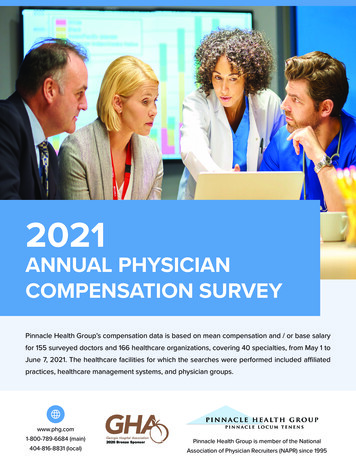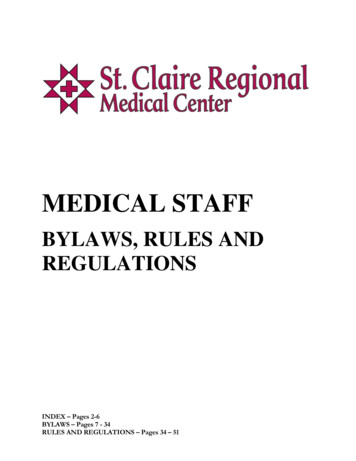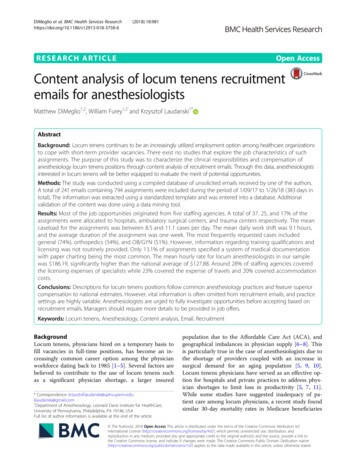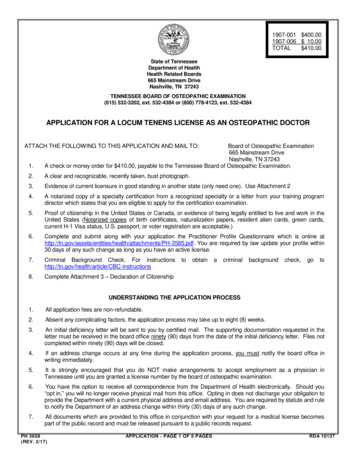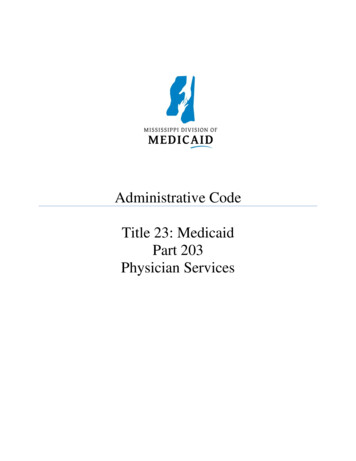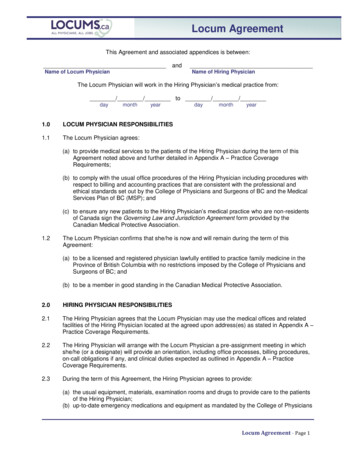
Transcription
Final publication is available from Mary Ann Liebert, Inc., publishers http://dx.doi.org/10.1089/tmj.2014.0159Locum Tenens and Telepsychiatry: Trends in Psychiatric Care1Jonathan Stuart Thiele, MD1, Charles R. Doarn, MBA2, Jay H. Shore, MD, MPH1Univeristy of Colorado Anschutz Medical Campus, Aurora, Colorado and 2Family andCommunity Medicine, University of Cincinnati, Cincinnati, OhioBrief CommunicationsTables – noneFigures – 2Running Head – Locum Tenens and Telepsychiatry in the Psychiatry ShortageCorresponding Author:Jonathan S. Thiele, MDDenver Health PsychiatryChief ResidentUniversity of Colorado Denver13001 E 17th PlaceMail Stop F546Aurora, CO 80045Phone: 303-724-1000Fax: 303-724-9472E-mail: jonathan.thiele@ucdenver.edu1
AbstractBackground: There is a national shortage of psychiatrists, and according to nationally availabledata, it is projected to get worse. Locum tenens psychiatry and telepsychiatry are two ways to fillthe shortages of psychiatric providers that exist in many areas in the United States (U.S.).Employment and salary data in these areas can be used to illuminate current trends and anticipatefuture solutions to the problem of increasing demand for, and decreasing supply of, psychiatristsin the U.S. Methods: A search was conducted of the literature and relevant websites includingPubMed, Google Scholar, www.google.com, and information obtained from locum tenens andtelepsychiatry organizations. Results: There is a dearth of data on the use of locum tenens in thefield of psychiatry with little available prior to 2000 and few published studies since then. Themajority of the data available is survey data from commercial entities. This data shows trendstoward increasing demand for psychiatry along with increasing salaries and indicates theutilization of telepsychiatry and locum tenens telepsychiatry are increasing. The publishedacademic data that is available shows that while locum tenens psychiatry is slightly inferior toroutine psychiatric care, telepsychiatry is generally equivalent to face-to-face care. Conclusion:One can anticipate that as the national shortage of psychiatrists is expected to accelerate, use ofboth locum tenens and telepsychiatry may also continue to increase. Telepsychiatry offersseveral possible advantages including lower cost, longer term services, quality of care, andmodels that can extend psychiatric services. If current trends continue, systems that demandface-to-face psychiatry may find themselves paying higher fees for locum tenens psychiatrists,while others may employ psychiatrists more efficiently with telepsychiatry.Keywords: locum tenens, telepsychiatry, psychiatry, shortage, salaries2
IntroductionThe growing need for psychiatric care is currently being exacerbated by an aging population,an increase in veterans requiring psychiatric support in the aftermath of military service, theinflux of patients from the Patient Protection and Affordable Care Act, and the concentration ofspecialists in urban settings with more limited access in rural and less desirable areas.1,2,3 TheUnited States (U.S.) and the world are facing a shortage of psychiatrists and allied mental healthprofessionals.4,5 There are an estimated 80 million Americans without adequate access to mentalhealth professionals.6 A majority, 55%, of the nation’s 3,100 counties have no psychiatrists,psychologists, or social workers2, and the numbers of psychologists and social workers are fargreater than psychiatrists in the U.S. (11 psychiatrists per 100,000 population).13 Only 65% ofadults with a serious mental illness in 2012 received any treatment, the most common being aprescription.13 Factoring in moderate and mild mental illness, the majority of adults received nomental health treatment in 2012; even less so among children with only 20% of those receivingtreatment.13 The Association of American Medical Colleges estimates that the country needs2,600 more psychiatrists to eliminate the 3,900 mental health professional shortage areas.4 Theshortage of psychiatrists is expected to grow with the aging population, with 59% found to beover the age of 55.6 Furthermore, psychiatry has the highest annual turnover rate of any medicalspecialty at 12.5%.6 Figure 1 illustrates the shortage of mental health clinicians in the U.S.Telepsychiatry, in the form of videoconferencing, has shown great promise in redressingaccess and workforce distribution issues.9,10 However, telepsychiatry alone cannot resolve thepsychiatric workforce shortage. Locum Tenens, from the French “holding place”, is the practiceof healthcare professionals being paid to take over the position of another professional,3
especially where the need justifies the often higher fee. Locum tenens has been the moretraditional solution in the field to address psychiatric workforce shortages.We wanted to review and compare the current trends in locum tenens and telepsychiatry toaddress psychiatric workforce needs with a focus on the role and implications for the field oftelepsychiatry in this area.MethodsA search was conducted of the literature and relevant websites including PubMed, GoogleScholar, and www.google.com, and information was obtained via a phone interview anddiscussions with locum tenens and telepsychiatry recruiters. Data on the use of locum tenenspsychiatry and telepsychiatry was obtained from employer surveys, including the Survey ofTemporary Physician Staffing Trends 2014 from Staff Care Inc., nine years of annualPsychiatrist Salary Survey Reports from www.locumtenens.com, and phone conversations withlocum tenens and telepsychiatry employees. Data obtained was compared with statistics onpsychiatric employment and salaries from the national Bureau of Labor Statistics.ResultsInternet searches revealed over 120 locum tenens companies in the US. The market forplacing locum tenens psychiatrists is dominated by five companies: Staff Care, CompHealth,LocumTenens.com, Barton Associates, and Weatherby Healthcare.10 Most companies follow theguidelines of the National Association of Locum Tenens Organizations.11 Increasingly,behavioral health facilities are dependent on locum tenens providers to fill staff shortages, withan estimated 3,600 psychiatrists having worked on a locum tenens basis in 2013 ( 10% of U.S.total psychiatrists).6 Behavioral health is the most common requested locum tenens specialty at34.6% of U.S. healthcare facilities, yet only 21.2% of facilities were able to fill locum tenens4
behavioral health positions in 2013.6 One article reported 2.54 requests for a locum tenenspsychiatrist for every locum tenens psychiatrist that was placed.14 Salaries of locum tenenspsychiatrists are well above the national average salary for a psychiatrist, demonstrating the highdemand and limited supply, as shown in Figure 2.The one published article on the quality of locum tenens psychiatrists showed that locumtenens psychiatrists provided slightly lower levels of value to psychiatric treatment teamscompared to non-locum tenens psychiatrists.7 Comparatively, articles on the quality oftelepsychiatric care have generally found it to be as effective as face-to-fare care.9,10,23 There arepotential cost and coordination advantages to telepsychiatry.24,25There are an estimated 600 companies in the newer and less organized telepsychiatryindustry.12 In 2013 a small percentage, 13.1%, of U.S. healthcare facilities used telepsychiatry6(15.4% in 2010 in another survey13). Broader data on the use of telemedicine does shows a trendof increasing use, with 43.5% of healthcare facilities using telemedicine in 2013.6 In 2014,Medicaid in 43 states and private insurance in 19 states were paying for telepsychiatry as a resultof state legal requirements.26 Locum tenens psychiatric recruiters that were interviewed reportedthat telepsychiatry is, by far, the fastest growing part of their companies. They and telepsychiatrycompany employees cited report the ability to work from home being one of the number onedraws for telepsychiatry positions. The fill rate for telepsychiatry positions at one locum tenenscompany was 89%, much higher than for face-to-face locum tenens psychiatry. When therecruiters are unable to fill locum tenens psychiatry positions, they often help the facilities set uptelepsychiatry services.10 One Web-based employment site listed the average salary for atelepsychiatrist in 2014 as 113,00018, well below the 182,660 that the average psychiatrist inthe U.S. made in 2013.15 Although it is unclear, the reason for this may be an artifact of more5
part-time work by those who choose the work due to the convenience of schedule and homelocation.19ConclusionBoth telepsychiatry and locum tenens psychiatry are increasingly playing a role in addressingthe distribution and access issues of regional and localized shortages of psychiatrists in the U.S.Though information in these industries is protected for proprietary reasons, the data we havefound does show increasing use and increasing demand, as would be expected given theincreasing shortage of psychiatrists. Both are viable alternatives to face-to-face psychiatry, as thelimited academic data available suggests that while locum tenens psychiatry has been found to beslightly inferior to routine psychiatric care, telepsychiatry has generally been found to beequivalent to face-to-face care.The overall number of psychiatrists in the U.S. is not likely to increase unless the number ofresidency positions were to increase significantly (from 2005 to 2010, the number of psychiatricresidency positions did increase somewhat from 1,286 to 1,395).20 Allied health professionals,such as physicians assistants and nurse practitioners, may play an increasing role in prescribingfor mental health conditions, however training programs for them in psychiatry are limited andthey generally require supervision from a physician to prescribe.2While more has to be done to address the overall shortage of psychiatrists in the U.S., locumtenens psychiatry and telepsychiatry are two established and growing tools that will seewidespread adoption as shortages of physicians worsens. Telepsychiatry positions are often filledby locum tenens psychiatrists, and a greater proportion of psychiatry positions in the future maybe expected to be locum tenens, telepsychiatry, or both. Telepsychiatry can be used as a careforce multiplier by increasing the accessibility to supervision of allied care professionals as well6
as by the implementation of emerging models of telepsychiary such as store-and-forwardtelepsychiatry and virtually integrated behavioral healthcare through which team-based careincreases the number of patients a psychiatrist can provide oversight of.27,28Preliminary data suggest that telepsychiatry may also have some advantages in terms oflower cost than locum tenens and more sustainable long term services. Ultimately, healthcarereform and marketplace dynamics will continue to shape these evolving models of psychiatricworkforce coverage. If current trends continue, systems that demand face-to-face psychiatry mayfind themselves paying more to locum tenens companies to recruit from among a dwindling poolof psychiatrists, while others may employ a lesser amount of psychiatrists more efficiently byusing telepsychiatry.AcknowledgementWe would like to acknowledge the support of the Psychiatry Residency Program at theUniversity of Colorado, Denver, as well as the University of Colorado Depression Center.Author Disclosure StatementThe authors do not have any disclosures to report.References1. Hermes ED, Rosenheck RA, Desai R, Fontana AF. Recent trends in the treatment ofposttraumatic stress disorder and other mental disorders in the VHA. Psychiatric Services,2012; 63(5):471-76.2. Fields G, Dooren JC. For the Mentally-Ill, Finding Treatment Grows Harder. New healthcare law may add to crunch for enough treatment. The Wall Street Journal, 2014, Jan 52702304281004579218204163263142(Accessed July 5, 2014).7
3. MacDowell M, Glasser M, Fitts M, Nielsen K, Hunsaker M. A national view of rural healthworkforce issues in the USA. Rural Remote Health 2010; 10(3):1531.4. Smydo S. Psychiatrists in short supply nationwide. Lower pay, limited respect for idePittsburgh/stories/201403160076 (Accessed July 5, 2014).5. Bruckner TA, et. al. The mental health workforce gap in low- and middle-income countries:a needs-based approach. Bulletin of the World Health Organization 2010; Nov 784/en/ (Accessed July 5, 2014).6. Staff Care, Inc. 2014 Survey Of Temporary Physician Staffing Trends. urvey-of-temp-physicians.pdf(AccessedMarch 7, 2014).7. Davis GE, Lowell WE, Davis GL. A Comparative Study of the Psychiatric Care betweenLocum Tenens and Staff Physicians at a State Hospital. Am J Medical Quality, 1998;13(2):70-80.8. Shore JH. Telepsychiatry: Videoconferencing in the Delivery of Psychiatric Care. The A JPsychiatry, 2013; 170:256-62.9. O’Reilly R, Bishop J, Maddox K, Hutchinson L, Fisman M, Takhar J. Is TelepsychiatryEquivalent to Face-to-Face Psychiatry? Results from a Randomized Controlled EquivalenceTrial. Psychiatr Serv, 2007; 58(6):836-43.10. Brocksmith J. Psychiatry Recruiter at locumtenens.com. Phone interview, 2014, February 5.11. National Association of Locum Tenens Organizations. NALTO Company Members. 2014.http://www.nalto.org/nalto-companies/ (Accessed March 8, 2014).8
12. sons-why-telepsychiatry-hot (Accessed March 8,2014).13. Substance Abuse and Mental Health Services Administration. Behavioral Health ehavioralHealthUS/2012-BHUS.pdf(Accessed March 8, 2014).14. Weiss GG. Is the locum lifestyle right for you? Med Econ, 2003; 80(6):78-79.15. Bureau of Labor Statistics (2005-2012). Occupational Employment Statistics, 2005 – 2012.http://www.bls.gov/oes/tables.htm (Accessed February 6, 2014).16. intage /data/historical/2000s/index.html (Accessed February 28,2014).17. ychiatrist-salary-survey/–2013.(AccessedFebruary 6, 2014).18. SimplyHired. Average Telepsychiatry Salaries, 2014. y-jobs.html (Accessed July 5, 2014).19. Maddoloni S. Telepsychiatry Solutions for Hospitals and Clinics. e-psychiatry.com, 2013,Feb 2. ation-Hospitals-and-Clinics.pdf(Accessed July 5, 2014).9
20. Center for Workforce Studies. 2012 Physician Specialty Data Book. Association of amc.org/eweb/upload/12-039%20Specialty%20Databook final2.pdf (Accessed July 5, 2014).21. Psychiatry CAQ. National Commission on Certification of Physicians Assistants. 2014.http://www.nccpa.net/Psychiatry (Accessed July 5, 2014).22. Rural Assistance Center. Health Professional Shortage Areas (HPSA) – Mental line.org/racmaps/mapfiles/hpsa mentalscore.png(Accessed2014.March9,2014).23. Hilty DM, Ferrer DC, Parish MB, Johnston B, Callahan EJ, Yellowlees PM. TheEffectiveness of Telemental Health: A 2013 Review. Telemed J E Health, 2013; 19(6):44454.24. Saeed SA, Diamond J, Bloch RM. Use of Telepsychiatry to Improve Care for People WithMental Illness in Rural North Carolina. N C Med J, 2011; 72(3):219-22.25. Deslich SA, Thistlethwaite T, Coustasse A. Telepsychiatry in Correctional Facilities: UsingTechnology to Improve Access and Decrease Costs of Mental Health Care in UnderservedPopulations. Perm J, 2013; 17(3):80-86.26. National Conference of State Legislatures. State Coverage for Telehealth Services, erage-for-telehealth-services.aspx(AccessedJuly 27, 2014).27. Fortney JC, Pyne JM, Mouden SB, Mittal D, Hudson TJ, Schroeder GW, Williams DK,Bynum CA, Mattox R, Rost KM. Practice-based versus telemedicine-based collaborative10
care for depression in rural federally qualified health centers: a pragmatic randomizedcomparative effectiveness trial. Am J Psychiatry, 2013; 170(4):414-25.28. Yellowlees PM, Odor A, Parish MB, Iosif AM, Haught K, Hilty D. A feasibility study of theuse of asynchronous telepsychiatry for psychiatric consultations. Psychiatr Serv, 2010;61(8):838-40.11
Locum tenens has been the more traditional solution in the field to address psychiatric workforce shortages. We wanted to review and compare the current trends in locum tenens and telepsychiatry to address psychiatric workforce needs with a focus on the role and implications for the field of telepsychiatry in this area. Methods

